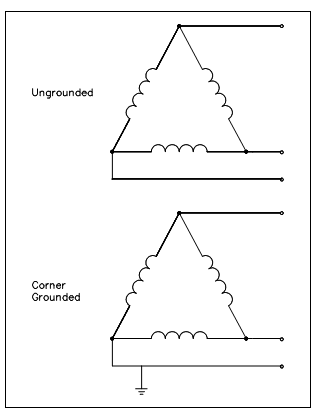Three-Phase Delta System:
The simplest three-phase system is the 3-wire Delta configuration, generally used for transmission of power in the intermediate voltage class from around 15,000 volts to 600 volts. The figure in Figure depicts the two techniques of connecting the Delta secondary.

Figure 3 Wire, Three-Phase Delta Scheme
The upper diagram depicts the ungrounded Delta, generally confined to protected environments like as fully enclosed ducts or overhead transmission lines which cannot b e r e a c h e d w i t h o u t extraordinary means. Every conductor's ground voltage is equal to the full phase voltage of the system.
The lower diagram display a ground point affixed to one corner of the Delta, that effectively lowers one phase's voltage reference to ground to zero, but retains a phase-tophase voltage potential. The corner-grounded phase acts in much the similar way as the grounded neutral of the singlephase Edison system, carrying current and managing ground potential.
The corner-grounded Delta system has an obvious economy in wiring costs, and the grounded phase could be used to physically protect the other two phases from accidental grounding or lightning strikes in outdoor settings. This system is rarely used for low voltage (under 600 V), therefore, since of the absence of a safety ground required through several facilities for circuits included potential worker contact.